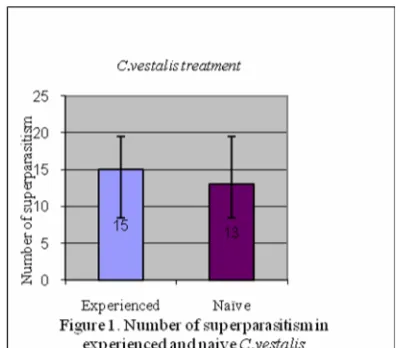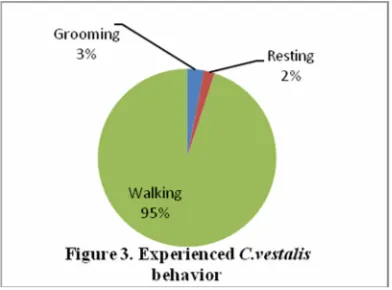SELF- SUPER PARASITISM BEHAVIOR
OF NAÏVE AND EXPERIENCED
COTESIA VESTALIS
, A BIO-CONTROL AGENT OF
Plutella Xylostella
IN BRASSICA CROPS
Uma Khumairoh*)and Catlyn Panjdaitan Laboratory of Entomology, Droevendaalsesteeg 1
Building 107 (Radix) 6708 PB, P.O. Box 8031, 6700 EH Wageningen, The Netherlands Biological Farming System Group
Droevendaalsesteeg 1 Building 107 (Radix) 6708 PB P.O.Box 563, 6700 AN Wageningen, The Netherlands
*)
Corresponding author E-mail: uma.khumairoh@wur.nl/ umakhumairoh@yahoo.com
Received : August 19, 2010 / Accepted : September 3, 2010
ABSTRACT
Cotesia vestalis is one of the parasitoids of Plutella xylostella,. They do self-superparasitism to predicted as a behavior to increase the proportion of their female offspring or as a behavior resulting from their inability to recognize previously parasitized hosts. Observations were conducted to study the behavior of experienced and naive Cotesia vestalis. The age of C. vestalis females for observation was between one to three days after emerging for both experienced and naïve, but experienced C. vestalis were trained to lay eggs before real observation. The observation was done in a laboratory and included five behaviors, namely number of ovipositions and host encounters, period of grooming, walking and resting. There was no significant difference in the proportion experienced and naïve C. vestalis females that superparasitized. The number of ovipositions and host encounters, periods of walking, grooming and resting were also not significantly different between experienced and naïve C. vestalis. For further research, it is recommended to observe behavior of C. vestalis that differ in age and after longer periods of experience training. Additional behavior such as direction preferences (leaf or patches), host preference (host health and color) can additionally be important variables to study in C.vestalis behavior.
Keywords: Superparasitism, C. vestalis, naïve, experienced, behavior
INTRODUCTION
Plutella xylostella (diamondback moth) is known for causing damage to brassica crops. Larvae of this insect feed all of above ground parts of the plant which reduces yield in quality and quantity. The most common method to combat this insect is through insecticides. However, this insect becomes more resistant to chemical and biological pesticides (Li et al., 2007). Therefore, integrated pest management through biological control is developing to solve this problem. Parasitoids are effective organisms as biological control agents. Introduction of parasitoids can decrease damage caused by Plutella xylotella (Yang, Chu, and Talekar, 1994).
and eggs because only one offspring can be produced per host in solitary parasitoids.
However, other researchers have insisted that in some cases superparasitism may be adaptive behavior. van Alphen and Visser (1990) in Riddick (2008) stated that self-superparasitism may be beneficial if the presence of two or more eggs per host increases the overall chance that one parasitoid will survive, if the encounter rate with healthy unparasitized hosts is low. The competition between offspring may also select for stronger and superior female offspring and may increase the proportion of female offspring (Hubbard et al., 1999; Riddick, 2008).
There may be a relation between superparasitism behavior and the level of experience of a parasitoid. In particular, experience in host searching and handling may be relevant. Response of parasitoid to chemical and visual cues is important in host searching. This behavior can change through repeated experience. However this experience also can be forgotten and continue change little with further experience (Vet and Dicke, 1992).
Understanding of behaviour and tendency of naive or experienced parasitoids to do superparasitsm may help to identify the effective attributes used by parasitoids to exploit host resources efficiently, and thus to assess the suitability of parasitoids in biological control of insect pests. In this experiment, we study oviposition behavior in relation to self-superparasitism of naïve and experienced Cotesia vestalis. It is hoped that the obtained information later can provide knowledge about development interaction between a host and a parasitoid.
The objective of this experiment was to observe the superparasitism behavior of experienced and naïve Cotesia vestalis and to know whether there is different behavior between them in searching and handling hosts. We hypothesized that experienced C. vestalis will be more selective in finding and ovipositing in hosts than naïve C. vestalis.
MATERIALS AND METHODS
The study was conducted on 21st January to 21st February 2010 in climate room of Entomology Department of Wageningen University. There are four different rooms used
for this experiment, namely room for Plutella xylostella, cabbage plants, C. vestalis, and observation. The observation room was in a climate controlled room adjusted to the natural environment of C.vestalis with temperature 25oC, 60% of relative humidity and supported by electronic lamps for lighting.
Materials used in this study were:
-Plutella xylostella as the host, were maintained on cabbage plants (Brussels sprouts) in a controlled room.
- Cotesia vestalis females were maintained and mixed with males in a cage with sugar water and a cabbage leaf for one to three days after emergence. Therefore, they were assumed to treatments (experienced and naïve C. vestalis). Each treatment was replicated 20 times.
The Preparation should be done were :
One day before experiment, C. vestalis were separated into experienced and naïve treatments. Every single experienced and naïve C. vestalis was placed individually in a Petri dish with a piece of cabbage leaf (+/- 3cm x 3 cm) and 3 drops of honey for their food. There were three groups of Petri dish training in laying eggs in one night.
Naïve Petri dish: consisted of honey, a were removed just before the observation.
experiment. Five hours later, around 1 p.m., the real observation was done. Two hosts in the Observation Petri dish were removed, and two hosts left were painted with red and white colour, to make easier in differentiate while observing.
Observations
The individual C. vestalis was released into the observation Petri dish. This dish contained damaged leaf to give them cues in recognizing their host and two painted hosts (red and white). Observations recorded included the number of ovipositions and host encounters (when C. vestalis approached the hosts but did not oviposit), and searching behavior such as periods of grooming, walking and resting within 15 minutes.
Data analysis
Collected data was analyzed with Z-test at 0.05 significant levels for categorizing superparasitism behavior. To analyze number of ovipositions, number of encounter, period of grooming, walking and resting non parametric analysis were used.
RESULTS AND DISCUSSION
RESULTS
From 20 C. vestalis in each treatment, there were 15 experienced and 13 naïve of C. vestalis that did superparasitism (Figure 1). The result of statistical analyses using Z-test on the number of superparasitism in experienced and naïve C. vestalis was not significant (p-value= 0.14, Sd= 0.14).
Table 1. Superparasitism tendency of Naïve and experienced C.vestalis
Experienced Naive
Category Number
of C.vestalis
Ovipositions average
Encounter average
Number of C. vestalis
Ovipositions average
Encounter average
Superparasitism (S) 15 4 3.1 13 5 4.1
Non-Superparasitism
(NSp) 4 1 2.5 2 1.5 2
Table 2. Periods of searching behavior (second)
Behavior Naive Experienced
Grooming 65.3 27.2
Resting 53.3 17.4
Walking 772.3 848.3
Figure 2 shows the average number of ovipositions and encounters in naïve C. vestalis (oviposition= 5, encounter= 4.1) was higher than in experienced C. vestalis (ovipositions= 4, encounter= 3.1). Based on non parametric statistical analyses, the different number of ovipositions and encounters were not significant (p-value of oviposition = 0.15, Sd= 2 and p-value of encounter = 0.47, Sd= 2.6).
In Figures 3 & 4, period of grooming and resting in naïve were longer than in experienced (7% and 6% respectively for naïve and 3% and 2% for experienced), but period of walking was higher
in experienced (95%). Non parametric statistical analyses showed that these differences in three variables (grooming, resting and walking) were also not significant (p-values for walking, grooming and resting were 0.05 (Sd= 113), 0.09 (Sd= 75.5) and, 0.95 (Sd= 87) respectively).
DISCUSSION
The result showed that both experienced and naïve of C. vestalis tend to do superparasitsm. The higher number of superparasitism in experienced treatment resulted from the higher number of naïve C. vestalis that did not oviposit at all. It might be because some naïve C. vestalis were not motivated to sting and probably need more time to find hosts. According to Wang et al. (2002), behavior of C. plutellae (=C. vestalis) was random in flying and ovipositing because they are ineffective in using volatile semiochemicals. This may also have happened in naïve C. vestalis in our experiment.
The number of host encounters in experienced C. vestalis was higher than in naïve, but opposite was found with the number of ovipositions. It might be because experienced C. vestalis was familiar with the host target, which we observed with some additional behaviors. For example the experienced C. vestalis would directly go to damaged leave and folded leaf to search the host, but naïve C. vestalis were only walking around host excreta patches and doing movement similar to sting in all patches.
Naïve C. vestalis tends to do grooming every time they found host patches. But the experienced did less grooming. In the experiment by Wang et al. (2002) C. plutella tend to search their host in the narrow area and when they found damaged leaf they would antennate and groom. This supports our finding of naïve C. vestalis tending to groom every time they found the track of hosts or even host’s excreta.
Naïve wasps also rested more and moved their antennae while resting; probably they tried to be familiar with the host and used their antennae to detect them. However, the period of walking in experienced C. vestalis was higher than in naïve C. vestalis although this was not significant statistically. Walking behavior in this experiment was also assumed as searching behavior. By training with 10 hosts, experienced C. vestalis were expected to find more hosts during the experimental period. Therefore, they kept on searching continuously by walking to search hosts.
CONCLUSION AND SUGGESTIONS
Both experienced and naïve Cotesia vestalis tend to do superparasitsm and there is no significant different between experienced and naïve C. vestalis in their superparasitsm behavior such as walking, resting, grooming, encounter and ovipositions.
For further observations, including C. vestalis of different ages or increasing the period of training of experienced C. vestalis might be helpful to get better understanding in experienced and naïve C. vestalis superparasitism behavior. Moreover, additional behavior such as direction preference (leaf or patches) and host preference (host health and color) could be valuable information in observing superparasitism behavior.
REFERENCES
Darrouzet E.,E. Imbert and C. Chevrier. 2003. Self-superparasitism consequences for offspring sex ratio in the solitary ectopara-sitoid Eupelmus vuilleti. Entomologia Experimentalis et Applicata 109: 167–171 Dorn S. and N. Beckage. 2007. Superparasitism in
gregarious hymenopteran parasitoids: ecological, behavioural and physiolo-gical perspectives. Physiological Entomology 320: 199–211.
Hubbard, S.F., I.F.Harvey and J.P. Fletcher. 1999. Avoidance of superparasitism: a matter of learning? Animal Behav 57:1193–1197. Li. D., N. Schellhorn and O.Schmidt, ,(2007).
Detection of parasitism in diamondback moth, Plutella xylostella (L.), using differe-ntial melanization and coagulation rela-tions. Bulletin of Entomological Research 97: 399–405
Riddick E. W. 2008. Sting frequency and proge-ny production of lab-cultured Cotesia marginiventris. Bio Control 53:295–302. Salaki, C.L., L. Sembiring, J. Situmorang and
N.S.N.Handayani. Isolasi dan Karakterisasi Bakteri Indigenous Indone-sia (Bacillus thuringensis) yang Berpotensi sebagai Agensia Pengen-dalian Hayati terhadap Hama Serangga Kubis (Crocido-lomia binotalis). Agrivita 32 (2):174-181 van Alphen J. J. M. and Visser M. E. (1990).
Superparasitism as an adaptive strategy for insect parasitoids. Entomol 35:59–79. Wang, X.G. & Keller, M.A. (2002) A comparison of
the host-searching efficiency of two larval parasitoids of Plutella xylostella. Ecolo-gical Entomology 27: 105-114
Yamada, Y. & Miyamoto, K. (1998). Payoff from self and conspecific superparasitism in a dryinid parasitoid Haplogonatopus atratus. Oikos 81: 209-216.
Yang, J.C, Chu, Y.I., Talekar, N.S. (1994) Studies on the characteristic of parasitism of Plutella xylostella (Lep.: Plutellidae) by a larval parasite diadegma semiclausum (Hym.: Ichneumonidae). Entomophaga 39 (3/4): 397-406

